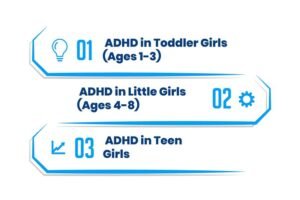The popular stereotype regarding ADHD was long-held and featured a fidgety young boy who could not sit well in his seat and constantly disturbed the other students for a long time. This stereotype has been making countless girls deviate silently, and their symptoms remain undiagnosed due to the inability to fit into the situation. The symptoms of ADHD in girls are commonly very different and exhibit inattentiveness, emotional sensitivity, and internal anxiety, as opposed to external hyperactivity.
This article will take you through the unique symptoms of the disorder, the process of making a diagnosis, and the most viable treatment approaches for girls with ADHD, from toddlerhood up to their teenage years. We will investigate age-related changes in symptoms and their comparison in cases of presentation.
The Quiet Struggle: Common ADHD Symptoms in Girls
Boys who display behavioral traits of hyperactivity and impulsivity tend to have ADHD, but girls tend to have the inattentive type. They also have see-through symptoms that are often less disruptive and major, and therefore difficult to notice by their parents and teachers. Instead of hitting the walls, an AD teenager could be gazing out of the window in her world.
The important insensitive symptoms are:
- Has often been said to be in his own world or to be spacey.
- Difficulty in listening to details in the classroom or while communicating.
- Always loses homework, books, or personal things.
- Sloppiest with an untidy backpack, locker, or bedroom, and disorganized time.
- May speaks in a multi-part manner, or almost like they are not listening.
In addition to inattentiveness, girls who experience ADHD usually have serious emotional problems. They are susceptible to extreme levels of frustration, fear, and depression, which make them worthless. They strive so hard to keep up with them, but their problems within fall earn them an inferiority or inadequacy complex.
ADHD Through the Ages: From Toddlers to Teens

1. ADHD in Toddler Girls (Ages 1-3)
Testing ADHD among toddlers is not easy, as most of the traits associated with toddlers, such as energy and short attention span, are similar to the effects of ADHD. But some trends can be indicative of a problem.
Symptoms among toddler girls may consist of:
- Very restless: Seems to move continuously as compared to their counterparts.
- Hardly able to sit and quietly do a short story or easy puzzle – difficult.
- Strong emotional responses: Experiences frequent heavy tantrums, which are difficult to calm.
- Functions: This happens due to a short attention span: Darts around among toys with no distraction.
2. ADHD in Little Girls (Ages 4-8)
When girls join school, the pressure on their attention and organizing skills grows as well, which makes them even more obvious.
Recurring symptoms in young girls comprise:
- Talking: May speaks a lot, is always rude, or speaks during a lecture.
- Social problems: Diagnosed to lack or have difficulty forming or maintaining friendships, is either perceived as missing social psychology or is oversensitive.
- Elsewhere on the checklist, the person having developmental challenges was struggling with organization; they were unable to track their school supplies and other multi-task actions.
- Emotional sensitivity: Cries frequently or gets easily frustrated at small setbacks.
3. ADHD in Teen Girls
It is the time of troubles during the teenage years of girls with ADHD. The stresses of academics increase, social dynamics get compounded, and certain hormonal changes may increase the symptoms. A lot of girls who did not have a diagnosis in their childhood finally crashed in middle or high school. Teenage girls have challenges that include:
- Problems with academics: Procrastination, inability to work on long-term projects, and inability to study for examinations pose a significant challenge.
- Social anxiety: May disagree that she is an outsider and is comfortable in harnessing into society, thus she interacts socially.
- Improved emotionality: The mood swings, irritability, and overwhelming emotions may become more severe because of hormonal changes.
- Risk of co-morbidity: The issue of undiagnosed ADHD in teen girls is associated with a high risk of anxiety, depression, eating disorders, and self-harm. They can employ their coping methods, such as perfectionism or people-pleasing, that can conceal their problems.
ADHD in Girls vs. Boys: Why It Looks So Different
The main cause of ADHD in girls being missed so frequently is that research and diagnosing criteria had previously been pegged on the studies of hyperactive boys. This resulted in a diagnostic bias that is present.
The following is a comparison of the typical presentation of ADHD in girls and boys:
- Primary Symptoms: Girls tend to express the inattentive symptom (daydreaming, disorganization), and boys, young males tend to exhibit the hyperactive-impulsive.
- Behavioral Expression: Boys are more disorganized in their struggle and put it outward in disruptive behavior. The struggles of girls are usually internalized and result in anxiety, withdrawal, and low self-esteem.
- Coping Mechanisms: In most cases, girls have elaborate masking techniques that they use to conceal their symptoms. They may either end up being perfectionists or work even harder than the rest to earn a living, which may conceal the difficulties in them until they are too exhausted to tolerate any more.
- Age of Diagnosis: Typically, boys receive a diagnosis at early elementary school because the samples of their conduct are noticeable. Girls get diagnosed very late, after probably years of struggling, and sometimes their teenage years or even adulthood.
Getting Answers: The ADHD Test and Diagnosis Process
Girls do not have a single test for ADHD. Comprehensive diagnosis is a complex process that is conducted through getting data about a child in different forms in order to create a holistic idea about the functioning of the child.
Comprehensive analysis usually involves:
1. Clinical Interviews: A health worker will perform a thorough interview of the parents and the girl herself. They will inquire about the symptoms, developmental history, as well as difficulties at school and home.
2. Behavior Rating Scales: Parents and teachers are assessed by standardized questionnaires, including the Vanderbilt or Conners, which assess various environments by rating the evaluation of frequency and most severe behaviors related to ADHD.
3. Review of Records: Evaluator could also visit school report cards, teacher remarks, and even past psychological assessments to examine whether there exist any patterns of difficulty exist that may be long-term in nature.
4. Ruling Out Other Conditions: It should be remembered that other conditions that are related to symptoms of ADHD should be excluded, including anxiety and depression, learning disabilities, or even hearing and vision impairment.
Pathways to Success: ADHD in Girls Treatment
Behavioral Therapy
The treatment of ADHD involves therapy. Cognitive Behavioral Therapy (CBT) is especially beneficial because it will allow the girl to:
- Learn to separate time, be organized, and subdivide large tasks using constant mechanisms.
- Refreeze negative thinking: Criticize the self and develop self-esteem.
- Learn to recognize the causes of frustration or anxiety and react healthily.
Medication Management
A medication is a potentially powerful instrument for dealing with core symptoms of ADHD. It is capable of enhancing concentration, impulsivity, and internal silence, that the inner noise created by worries and anxieties, rendering concentration a very hard task.
- Stimulants include Adderall and Ritalin, which are the most common and effective drugs. They act by elevating the concentration of some neurotransmitters in the brain.
- Non-Stimulants: Strattera and Qelbree are also some good alternatives to people who do not respond to the stimulants or have side effects.
Finding the right medication and dosage requires careful medication management with a healthcare provider. It often involves a trial-and-error process with regular check-ins to monitor effectiveness and side effects.
Final Remarks
Girls also tend to be misdiagnosed with ADHD in girls because the features of the disorder can be less obvious as including forgetfulness, lapse of concentration, or sensitivity. Early identification and treatment contribute to enhanced function and confidence as well as everyday performance through proper treatment. With the help of individual medication control and regular telehealth services, girls with ADHD will be able to get continuous assistance from the comfort of their homes.
These therapies can be used in controlling symptoms, emotional control, and improving academic and social performance. At mental behavioral , we are working to learn the individual needs of various people and working with them to create specific plans that promote growth and achievements. Your child may have a problem with attention, impulsivity, or emotional difficulties, and in any case, our understanding team has you.








